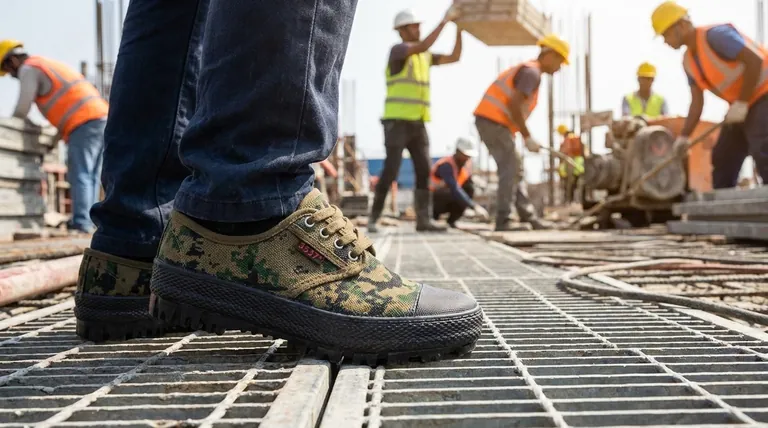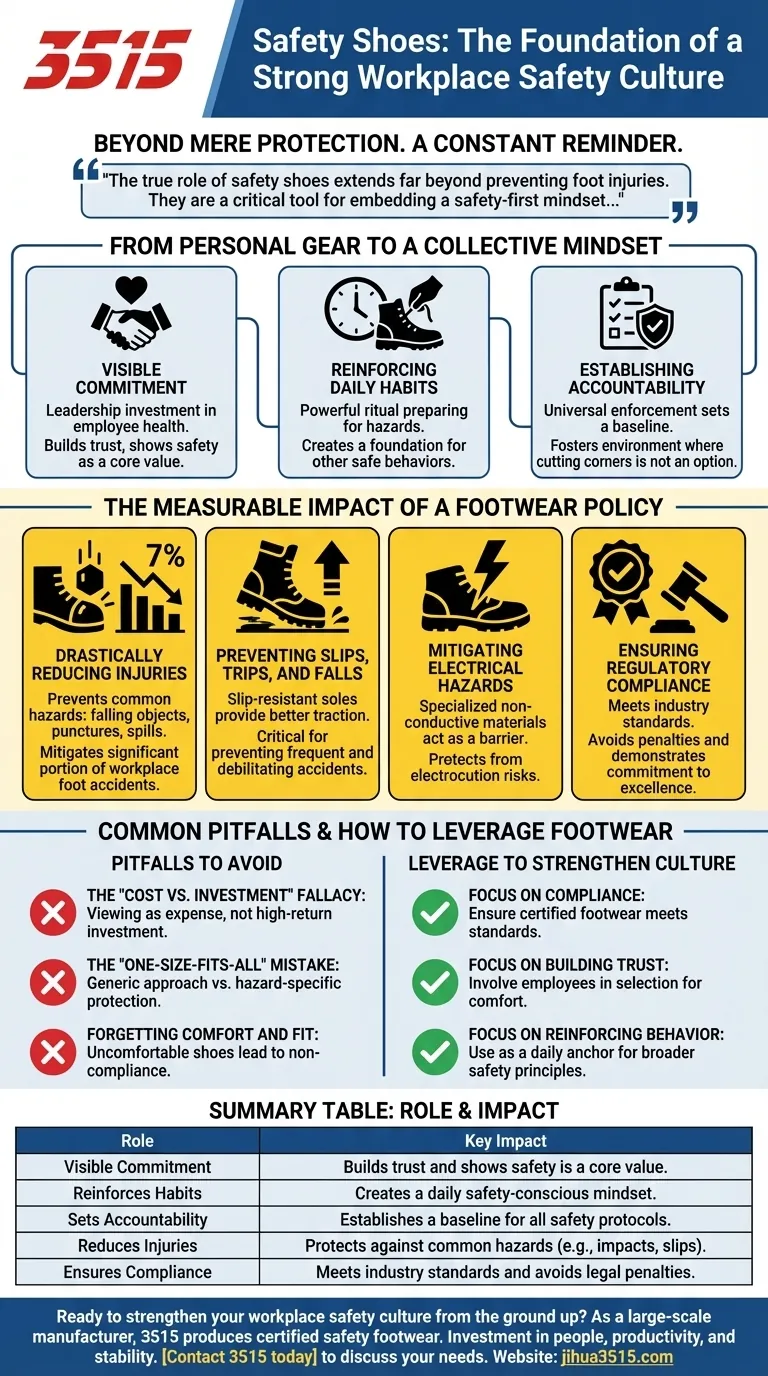Beyond mere protection, safety shoes are a foundational element of a strong workplace safety culture. They serve as a tangible, daily symbol of an organization's commitment to its employees' well-being, transforming a simple piece of equipment into a constant reminder that safety is a shared, non-negotiable responsibility.
The true role of safety shoes extends far beyond preventing foot injuries. They are a critical tool for embedding a safety-first mindset into the daily routine, visibly demonstrating an employer's commitment and setting a baseline standard for all other safety protocols.

From Personal Gear to a Collective Mindset
A robust safety culture isn't built on rules alone; it's built on visible actions and shared habits. Safety footwear is often the first and most consistent interaction an employee has with the company's safety program each day.
A Visible Commitment to Safety
Providing high-quality, appropriate safety shoes is a clear signal from leadership. It communicates that the organization is investing not just in compliance, but in the actual health and security of its people.
This tangible investment builds trust and shows that safety is a core value, not just a line item in a rulebook.
Reinforcing Daily Habits
The simple act of putting on safety shoes before starting a shift is a powerful ritual. It mentally prepares an employee for a hazardous environment and reinforces a safety-conscious mindset from the ground up.
This daily habit creates a foundation upon which other safe behaviors can be built, making the entire safety program more effective.
Establishing a Standard of Accountability
When the requirement for safety footwear is strictly and universally enforced, it sends a clear message: safety rules are not optional.
This establishes a baseline of accountability that makes it easier to enforce other, less visible safety protocols. It fosters an environment where cutting corners is not an option for anyone.
The Measurable Impact of a Footwear Policy
Implementing a comprehensive safety shoe program provides concrete, positive results that strengthen the entire organization. It moves the concept of "safety culture" from an abstract idea to a source of measurable value.
Drastically Reducing Common Injuries
The most direct impact is the prevention of injury. Well-chosen footwear protects against a wide range of common hazards, including falling objects, sharp object punctures, and chemical spills.
Statistics show that a significant portion of workplace accidents—around 7%—involve the feet. A proper policy directly mitigates this risk.
Preventing Slips, Trips, and Falls
Slip-resistant soles are a key feature that provides better traction on wet or uneven surfaces. This single feature is critical in preventing some of the most frequent and debilitating workplace accidents.
Mitigating Electrical Hazards
For environments with electrical risks, specialized safety shoes with non-conductive materials are essential. They act as a barrier against electrical currents, protecting workers from electrocution from malfunctioning equipment or live wires.
Ensuring Regulatory Compliance
Mandating certified safety footwear ensures the organization meets or exceeds industry safety standards. This not only avoids legal penalties and sanctions from labor inspections but also demonstrates a commitment to operational excellence.
Common Pitfalls to Avoid
Simply providing any safety shoe is not enough. A truly effective program requires thoughtful implementation to avoid common mistakes that can undermine the safety culture it's meant to build.
The "Cost vs. Investment" Fallacy
Viewing safety footwear as a mandatory expense is a critical error. The real costs are found in workplace injuries, lost productivity, and potential legal action.
The correct perspective is to see proper footwear as a high-return investment in personnel, productivity, and operational stability.
The "One-Size-Fits-All" Mistake
Different work environments present different hazards. A culture of safety excellence means providing the right shoe for the specific job—whether that requires puncture resistance, electrical hazard protection, or enhanced slip resistance.
A generic approach shows a lack of detailed care and can leave employees vulnerable.
Forgetting Comfort and Fit
If safety shoes are uncomfortable, employees may be tempted to not wear them or become distracted by the discomfort. A true safety culture considers the user's well-being.
Involving employees in the selection process to ensure a proper and comfortable fit dramatically increases compliance and shows that their input is valued.
How to Leverage Footwear to Strengthen Your Safety Culture
Use your safety shoe program as an active tool to reinforce your organization's commitment to worker well-being.
- If your primary focus is compliance: Ensure all selected footwear is certified to meet or exceed the specific industry standards relevant to your workplace hazards.
- If your primary focus is building trust: Involve employees in the selection process to guarantee comfort and proper fit, which proves their well-being is a top priority.
- If your primary focus is reinforcing behavior: Use the daily requirement of wearing safety shoes as a consistent anchor point in safety meetings to introduce and reinforce broader safety principles.
Ultimately, a company's policy on safety shoes is a direct and visible reflection of how much it values its people.
Summary Table:
| Role of Safety Shoes | Key Impact |
|---|---|
| Visible Commitment | Builds trust and shows safety is a core value. |
| Reinforces Habits | Creates a daily safety-conscious mindset. |
| Sets Accountability | Establishes a baseline for all safety protocols. |
| Reduces Injuries | Protects against common hazards (e.g., impacts, slips). |
| Ensures Compliance | Meets industry standards and avoids legal penalties. |
Ready to strengthen your workplace safety culture from the ground up?
As a large-scale manufacturer, 3515 produces a comprehensive range of certified safety footwear for distributors, brand owners, and bulk clients. We understand that the right shoes are an investment in your people, productivity, and operational stability.
Our production capabilities encompass all types of safety shoes and boots designed for specific hazards, ensuring comfort, compliance, and maximum protection for your team.
Contact 3515 today to discuss your needs and invest in a safer, more productive workplace.
Visual Guide

Related Products
- Wholesale Durable Camo Canvas Shoes with High-Traction Rubber Soles
- Puncture-Resistant Velcro Safety Boots for Wholesale & Custom Manufacturing
- Wholesale Customizable Suede Safety Boots - Puncture-Proof with Velcro Closure
- Wholesale Slip-On Safety Boots Manufacturer - Custom Puncture-Proof & Steel Toe
- Durable Steel Toe Safety Boots Wholesale & Custom Manufacturing
People Also Ask
- What types of clothing are not considered business casual? Avoid These Common Style Mistakes
- What is the purpose of ASTM International? A Guide to Global Quality Standards
- What is ASTM International and what does it do? A Guide to Global Standards
- What is the role of OSHA in workplace safety? Ensuring Compliance and Protecting Workers
- What are the four key aspects to consider when choosing high-quality safety footwear? Ensure True Anatomical Fit & Protection



















